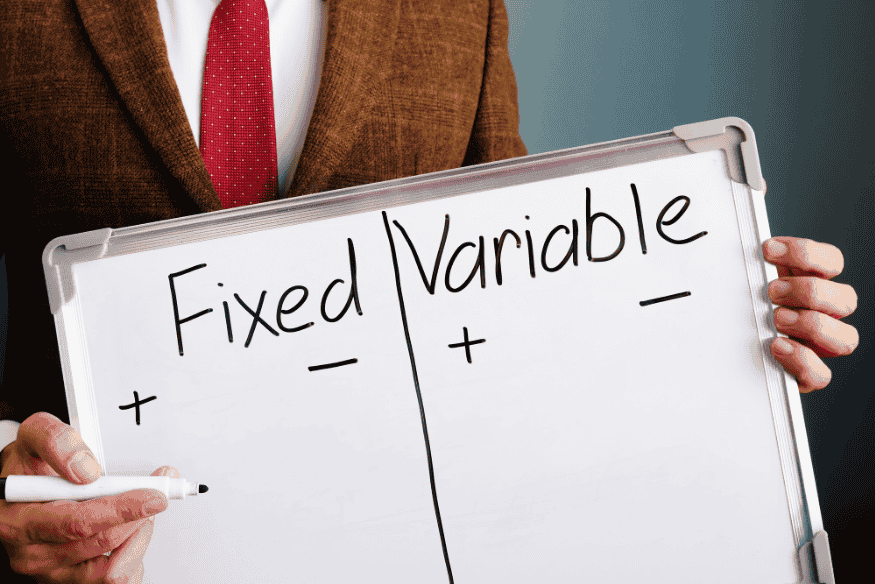When choosing a credit card, understanding how credit card interest rates work is one of the most important steps you can take for your financial well-being. These rates—whether fixed or variable—not only determine the cost of borrowing but also influence how easily you can manage debt over time.
The difference between a rate that stays the same (fixed) and one that can change based on market trends (variable) may seem small at first glance, but it can significantly affect your monthly payments, total interest paid, and long-term financial strategy. This is especially important in places like Finland, where cards may be tied to Euribor or influenced by decisions from the European Central Bank.
To make an informed decision, you need to understand how interest rates are calculated, how they impact your repayments, and which type aligns best with your financial habits and goals. This article will guide you through everything you need to know to confidently choose the credit card that best fits your needs.
Key Takeaways
- Understand the difference between fixed and variable interest rates.
- Learn how changes in interest rates can affect your credit card payments.
- Discover the factors to consider when choosing between fixed and variable interest credit cards.
- Find out how to manage your credit card debt effectively.
- Explore tips for selecting the best credit card for your financial situation.
Understanding Credit Card Interest Rates
Credit card APR, or Annual Percentage Rate, is a key part of your credit card deal. It shows the cost of borrowing money from the issuer. Knowing how credit card interest rates work is key to managing your debt well.
How Credit Card Interest Is Calculated
Credit card interest is usually based on your average daily balance. The issuer uses the APR to figure out the interest for the billing cycle. For example, with a 20% APR and a $1,000 average daily balance, the daily interest is about 0.0548%.
This daily rate is then multiplied by the average daily balance and the cycle days. This gives the total interest charged.
The Impact of Interest Rates on Your Monthly Payments
The interest rate on your credit card greatly affects your monthly payments. A higher APR means more interest, which can raise your minimum payment. On the other hand, a lower APR can lower your interest and payments.
Here’s a simple comparison:
| APR | Average Daily Balance | Interest Charge (30-day cycle) |
|---|---|---|
| 15% | $1,000 | $12.33 |
| 20% | $1,000 | $16.44 |
| 25% | $1,000 | $20.55 |
As shown, a small APR difference can lead to big interest charge differences over time. Understanding this can help you make better choices with your credit card.
Fixed vs Variable Interest: What’s the Difference?

When you’re looking at credit cards, knowing the difference between fixed and variable interest rates is key. This info helps you choose wisely, fitting your financial lifestyle and goals.
Fixed Interest Rate Explained
A fixed interest rate stays the same for your credit card’s whole life. This means your monthly payments are always the same, making budgeting simpler. For example, if your card has a 15% fixed rate, you’ll pay 15% interest on your balance every month.
Variable Interest Rate Explained
On the other hand, a variable interest rate can change with the market. It’s often linked to a benchmark rate, like Euribor. So, if Euribor goes up, your interest rate will too, affecting your monthly payments. Say your card’s rate is Euribor + 10%, and Euribor increases, your rate will go up as well.
How Banks Determine These Rates in Finland
In Finland, banks set fixed and variable interest rates based on a few things. These include your credit score, current market rates, and the bank’s policies. For variable rates, Euribor is a big factor. The European Central Bank’s policies also play a role. Knowing these can help you guess when your interest rate might change.
Pros and Cons of Fixed Interest Credit Cards
In Finland, fixed interest credit cards have good points and some not-so-good ones. It’s key to think about these when picking a credit card. This helps you choose one that fits your money goals.
Advantages of Fixed Interest Rates
Fixed interest rates have some great benefits for your money.
Predictable Monthly Payments
Fixed rates mean you know your monthly payments. This makes budgeting easier. It’s great for those who like to plan their money closely.
Protection from Rate Increases
Fixed rates keep your payments stable, even when rates go up. This is a big plus when money matters are uncertain.
Disadvantages of Fixed Interest Rates
But, fixed interest rates also have some downsides.
Typically Higher Initial Rates
Fixed interest cards often start with higher rates than variable ones. So, you might pay more interest at first, even if the rate doesn’t change.
Missing Out on Market Improvements
If rates drop, you could miss out on savings with a fixed rate card. This is something to think about, especially if you think rates will go down soon.
In short, fixed interest credit cards have both good and bad sides. Knowing these helps you pick the right card for your money needs and goals.
Pros and Cons of Variable Interest Credit Cards
Variable interest credit cards have both good and bad sides. Knowing these can help you decide if they’re right for you.
Advantages of Variable Interest Rates
One big plus is that they might start with lower rates than fixed-rate cards. This is great if you’re buying something big or need to adjust your payments.
Potentially Lower Initial Rates
- Lower introductory APRs can save you money on interest charges.
- More flexibility in managing your monthly payments.
Benefit from Favorable Market Changes
If interest rates drop, your card’s APR might go down too. This means you could pay less interest over time.
Disadvantages of Variable Interest Rates
But, variable interest cards have big downsides. The main issue is the unpredictable payment amounts. Rate changes can make your monthly payments go up or down.
Unpredictable Payment Amounts
- Changes in interest rates can lead to higher or lower monthly payments.
- Makes budgeting more challenging due to the uncertainty.
Risk of Significant Rate Increases
There’s also a risk of significant rate increases if the market changes badly. This could make your interest charges much higher, making it harder to pay off your balance.
How Economic Factors Influence Credit Card Interest Rates
Credit card interest rates are not set alone; they are shaped by many economic factors. Knowing these factors can help you choose better credit cards.
The Role of European Central Bank and Euribor
The European Central Bank (ECB) is key in setting interest rates in the Eurozone, including Finland. The ECB’s decisions, like setting the base interest rate, affect all interest rates. Euribor, the Euro Interbank Offered Rate, is also important. It’s a benchmark for many financial products, including credit cards with variable rates. When Euribor rates change, it can also change your credit card’s interest rate.
- Euribor rates are used as a reference rate for many credit cards.
- Changes in ECB’s base rate can influence Euribor.
- Variable interest rates on credit cards often follow Euribor movements.
Finnish Market Conditions Affecting Variable Rates
In Finland, market conditions and competition among banks also shape variable interest rates. In a competitive market, banks may adjust their rates to attract more customers. The economy’s health, including inflation and unemployment, also affects lenders’ rate decisions.
Key factors include:
- Competition among financial institutions.
- Economic indicators such as inflation and unemployment.
- Regulatory changes and banking laws.

Fixed Interest Cards: Ideal Scenarios for Finnish Consumers
Finnish consumers who like knowing what to expect financially might prefer fixed interest credit cards. These cards have a fixed rate, which means your payments stay the same. This makes budgeting easier and helps you plan your money better.
When Fixed Rates Make Financial Sense in Finland
Fixed interest rates are good when you don’t want surprises with your payments. If interest rates are going up, a fixed rate card can save you money. This is especially helpful if you always have a balance on your card.
Types of Spenders Who Benefit from Fixed Rates
Some people really benefit from fixed interest credit cards. These include those with long-term debt and those who are careful with their money.
Long-term Debt Carriers
For those with long-term debt, fixed interest cards offer stability. You’ll always know how much interest you’ll pay each month. This makes it easier to pay off your debt.
Budget-conscious Consumers
Fixed interest cards are also great for those who watch their budget closely. They give you control over your monthly costs. Knowing your interest payments helps you manage your budget better.
When looking at credit cards, think about your spending habits and goals. A credit card comparison can show if a fixed interest card is for you. By looking at the good and bad of fixed interest credit cards, you can choose what’s best for your money.
Variable Interest Cards: Ideal Scenarios for Finnish Consumers
For many Finnish consumers, variable interest credit cards can be a smart choice. They are often tied to the European Central Bank’s rates. These rates can change based on the economy.
When Variable Rates Make Financial Sense in Finland
Variable interest rates are good when interest rates are expected to go down. If you think Euribor rates will fall, a variable interest credit card can save you money.
Types of Spenders Who Benefit from Variable Rates
Certain types of credit card users in Finland can really benefit from variable interest rates.
Short-term Borrowers
If you’re borrowing for a short time and plan to pay off your card soon, a variable interest credit card is a good choice. You can enjoy lower rates without being stuck with a fixed rate for a long time.
Those Who Pay Off Balances Quickly
People who pay off their cards fast can also benefit from variable interest rates. Since you won’t have a big balance for long, the variable rate won’t hurt you much.
Understanding your spending habits and the current interest rates can help you decide if a variable interest credit card is right for you.
Analyzing Current Credit Card Offers in Finland
In Finland, you have many credit card options to choose from. It’s important to look at what’s available. The Finnish market offers both fixed and variable interest rates.
Popular Fixed Interest Credit Cards in the Finnish Market
Fixed interest credit cards are stable and predictable. Here are some top picks:
Traditional Bank Offerings
Nordea and Danske Bank have competitive fixed rates. For example, Nordea’s card has a rate of about 13.90%.
Online Bank Alternatives
OP and S-Bank offer fixed rates with lower fees than traditional banks.
| Bank | Fixed Interest Rate | Annual Fee |
|---|---|---|
| Nordea | 13.90% | €50 |
| OP | 12.90% | €30 |
| S-Bank | 13.50% | €40 |
Popular Variable Interest Credit Cards in Finland
Variable interest cards offer flexibility and sometimes lower rates. Here are some good choices:
Euribor-linked Options
Many Finnish cards are tied to Euribor, with variable rates. S-Bank and OP have these cards.
Special Promotional Offers
Some banks offer special rates for new customers. For example, Danske Bank sometimes has 0% interest for six months.
| Bank | Euribor-linked Rate | Promotional Offer |
|---|---|---|
| S-Bank | Euribor + 5% | No promotional offer |
| OP | Euribor + 4.5% | 0% for 6 months |
| Danske Bank | Euribor + 5.5% | 0% for 6 months (new customers) |
Strategies for Managing Credit Card Interest
Managing credit card interest is key to a healthy financial life. You can cut down on interest and make smart choices by using the strategies below.
Minimizing Interest Payments
To lower interest, look into balance transfer opportunities and payment optimization techniques. Balance transfers can move you to a card with lower rates, saving you money. For tips on balance transfers, check out credit card comparison guides.
Balance Transfer Opportunities in Finland
Finland has many credit cards with great balance transfer deals. Find cards with 0% interest for a while to save on interest.
Payment Optimization Techniques
Paying more than the minimum each month can cut down interest over time. Set up automatic payments to avoid missing payments.
When to Consider Switching Between Fixed and Variable Rates
Knowing when to switch rates can save you money. Watch economic indicators and switch if rates are going up.
Monitoring Economic Indicators
Keep up with economic trends and forecasts. The European Central Bank’s rate decisions can affect your card’s rate.
Timing Your Application for Maximum Benefit
Apply for a card when rates are low. If you’re eyeing a variable rate card, watch the market and switch to fixed if rates rise.
| Strategy | Benefit | Consideration |
|---|---|---|
| Balance Transfer | Save on interest with a lower rate | Check for transfer fees and promotional periods |
| Payment Optimization | Reduce total interest paid | Ensure you can afford increased payments |
| Switching Rates | Adapt to changing economic conditions | Monitor economic indicators and forecasts |
Making the Decision: How to Choose the Right Card for Your Needs

In Finland, picking the right credit card means looking at how you spend and what you want financially. There are cards with fixed and variable interest rates. Knowing your spending habits is key.
Assessing Your Financial Habits and Goals
Choosing the right credit card starts with understanding your finances. Think about how you spend, your income, and your financial goals. If you often carry a balance, a card with a low interest rate is important.
If you always pay off your balance, look for cards with rewards or cashback. These can offer more value for you.
Questions to Ask Before Applying for a Finnish Credit Card
Before you apply for a credit card in Finland, ask a few questions. What are the interest rates and how are they figured out? Are there any fees? Are there rewards or benefits that fit your spending?
Answering these will help you make a better choice when comparing cards.
Conclusion
You now know the key differences between fixed and variable interest credit cards. Think about your financial situation and goals when choosing. Fixed rates offer stability, while variable rates can be more flexible.
Look at your spending and financial goals to decide. If you often carry a balance, a fixed rate might be better. But if you pay off your balance each month, a variable rate could work for you. Knowing the pros and cons is key to picking the right card.
In short, pick a credit card based on your financial habits and goals. This way, you can manage your finances better and have a more secure financial future.









